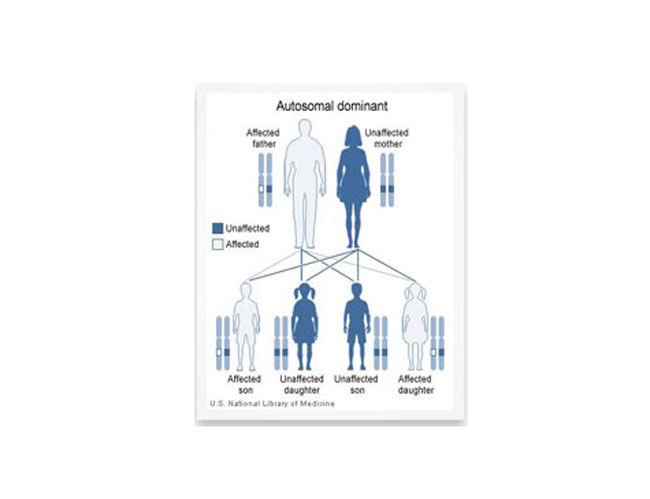DOMINANT INHERITANCE
Genes are the instructions or recipes made of DNA that tell our bodies how to build and repair themselves. We inherit our genes from our parents.
Our genes come in pairs and we inherit one copy in each pair from our mum and the other from our dad.
Each of the two different copies of a gene can have tiny differences in their genetic code. It is these subtle differences in our genes that make us all different and unique.
Sometimes a change in the genetic code of a gene can prevent the gene from working properly.
An individual with a dominant genetic condition will have a change or genetic misprint (which scientists call a mutation) in one copy of a particular gene. While the other copy of the gene is a working copy this is not sufficient to prevent the condition. The effects of the changed gene override the working copy.
Most often, someone with a dominant condition will have inherited their changed copy of the gene from one of their parents. The parent will therefore usually have the condition themselves, although some conditions vary widely in their severity. For a parent with a dominant genetic condition there is a 1 in 2 or 50% chance of passing the condition on to each child they have.
There is also a 1 in 2 or 50% chance that a child will not inherit the condition. This chance is the same whether the child is a boy or a girl. The chance also remains the same whether the child is first born, second born, third born etc. Some families will have three children who are all affected by the condition and others will not have any children with the condition. It is chance and probability, none of us can control which genes we pass on to our children.

Dominant inheritance. Photo: US Nat. Library of Medicine
The diagram above shows how dominant genetic conditions are inherited.
This You Tube video from UCD Dublin, National Children’s Research Centre Ireland explains how dominant inheritance works https://www.youtube.com/watch?v=yANF0bxHpzU
Dominant disorders
There are around 4,000 known inherited conditions that are caused by a difference in a single gene and many of these follow a dominant pattern of inheritance.
Osteogenesis Imperfecta (OI) or Brittle Bone Disease is most often inherited as a dominant condition. OI affects bone formation causing the bones to break easily, often with minimal or no apparent cause, and multiple fractures are common.
The condition affects about 6 people in every 100,000.
Watch Tiana and Star’s story about living with Brittle Bone Disease
You can also find out more about OI by visiting the Brittle Bone Society website http://www.brittlebone.org/
Other examples of dominant genetic disorders include Huntington’s Disease, Achondroplasia and Marfan syndrome.
Here’s a video we made for schools explaining What ‘Genes’ Means: https://www.youtube.com/watch?v=nBNeENaDA3s
Other Useful Links
National Genetics and Genomics Education Centre – Autosomal dominant inheritance https://www.genomicseducation.hee.nhs.uk/modes-of-inheritance/autosomal-dominant-inheritance
The Virtual Genetics Education Centre – Patterns of Inheritance http://www2.le.ac.uk/departments/genetics/vgec/highereducation/topics/inheritancepatterns/patterns-of-inheritance





